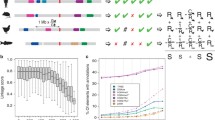Summary and conclusions
In the above discussion, I have outlined the current status of our efforts to use retroviral vectors to introduce selectable markers into the human genome and to use these markers for mapping specific chromosomal regions. I have not reviewed in detail the extensive characterization of the mouse H-2 region carried out by David Nelson and John Weis based on the insertion of a single retroviral element. This analysis has provided a model for the application of retroviral elements into various regions of the human genome. The prospects for increasing the resolution of the human genetic map and identifying many genes relevant to human health and development are likely to be enhanced by increasing the precision of this methodology.
Similar content being viewed by others
Literature cited
Miller, C.L., and Ruddle, F.H. (1978).Proc. Natl. Acad. Sci. U.S.A. 75:3987–3990.
Patterson, D., Graw, S., and Jonec, C. (1981).Proc. Natl. Acad. Sci. U.S.A. 78:405–409.
Willecke, K., Lange, R., Kruger, A., and Reber, T. (1976).Proc. Natl. Acad. Sci. U.S.A. 73:1274–1278.
Kao, F.T., Jones, C., and Puck, T.T. (1977).Somat. Cell Genet. 3(4):421–429.
Krieger, M., Kingsley, D., Sege, R., Hobbie, L., and Kozarsky, K. (1985)TIBS 10(11):447–452.
Mulligan, R.C. (1983). InExperimental Manipulation of Gene Expression, (ed.) Inouye, M. (Academic Press, New York), pp. 155–173.
Cone, R.D., and Mulligan, R.C. (1984).Proc. Natl. Acad. Sci. U.S.A. 81:6349–6353.
Nelson, D.L. (1984). Unpublished PhD thesis, MIT. Cambridge, Massachusetts.
Mann, R., Mulligan, R.C., and Baltimore, D. (1983).Cell 33:153–159.
Glaser, T., and Housman, D.E. (1984). InAdvances in Gene Technology: Human Genetic Disorders Proceedings, Miami Winter Symposium, Ahmad, F. (ed).
Lugo, T.G., Handelin, B.H., Killary, A.M., Housman, D.E., and Fournier, R.E.K. (1987).Mol. Cell. Biol. (in press).
Weis, J.H., Nelson, D.L., Pryzborski, M.J., Chaplin, D.D., Mulligan, R.C., Housman, D.E., and Seidman, J.G. (1984).Proc. Natl. Acad. Sci. U.S.A. 81:4879–4883.
Goss, S.J., and Harris, H. (1975).Nature 225:680–685.
Cepko, C.L., Roberts, B.E., and Mulligan R.C. (1984).Cell 37:1053–1062.
Reik, W., Weiher, H., and Jaenisch, R. (1985).Proc. Natl. Acad. Sci. U.S.A. 82:1141–1145.
Schwartz, D.C., and Cantor, C.R. (1984).Cell 37:67–75.
Kenwick, S., Patterson, M., Speer, A., Fishbeck, K., and Davies, K. (1987).Cell 48:351–357.
Burmeister, M., and Lehrach, H. (1986).Nature 324:582–585.
Handelin, B.L., Mulligan, R.C., and Housman, D.E. (in preparation).
Author information
Authors and Affiliations
Rights and permissions
About this article
Cite this article
Housman, D. Insertion of dominant selectable markers into the human genome. Somat Cell Mol Genet 13, 441–446 (1987). https://doi.org/10.1007/BF01534945
Issue Date:
DOI: https://doi.org/10.1007/BF01534945




